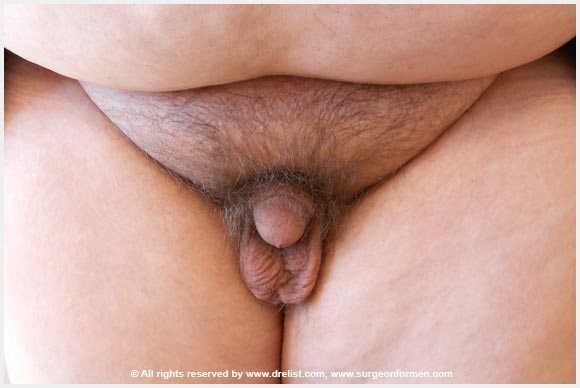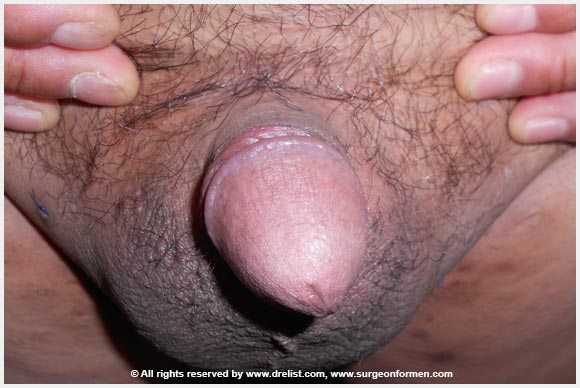Buried Penis Syndrome
Penis of normal size that lacks an appropriate sheath of skin
The term “buried penis syndrome” describes a penis of normal size that lacks an appropriate sheath of skin and is located beneath the integument of the abdomen, thigh, or scrotum. The penis may also be buried within its own skin.
Buried penis syndrome is a true congenital disorder commonly diagnosed in children, usually presenting in neonates or obese prepubertal boys; however, it can also be seen in adults and has been observed in both circumcised and uncircumcised individuals.

Causes of Buried Penis Syndrome
When Buried Penis Syndrome presents itself at birth, or at a very young age (Primary Buried Penis Sydrome), the cause has been described as a result of penile tissue dysgenesis, which results in trapping of the penis. In addition, a pubic fat pad might also be present, exaggerating the extent of concealment.
Pubertal and adolescent cases (Secondary Buried Penis Syndrome) are caused by obesity, radical circumcision, or lymphedema. Adulthood cases of Secondary Buried Penis Syndrome are more commonly a result of excessive fat deposition in the lower abdominal and pubic area. If the condition is caused by the lower abdominal and pubic area fat and skin tissue covering the penis it can create a moist condition ‘under the hood’ which results in skin infection, scarring, and adhesions with associated retraction. A congenital pubic fat pad can become especially problematic with age as the skin and fat sag and descend to cover the penis even more.
Buried Penis Syndrome Categories
Based on age, preexisting conditions and/or prior procedures, buried penis syndrome is usually classified in three major categories:
Concealed (before circumcision)
Trapped (scarred after circumcision)
Buried (associated with adolescence and obesity)
A less intense variety of a concealed penis is caused by a peno-scrotal web which causes obscuration of the penile shaft by scrotal skin. Webbed penis syndrome commonly presents with a normal sized penis covered by the scrotal skin at its lower portion causing the appearance of a “turkey neck” and a short appearance.
Buried Penis Syndrome
If excess penile skin is the cause of buried penis syndrome, a simple circumcision or the combination of circumcision and release of suspensory ligament is performed.
Circumcision can be done under local or general anesthesia. The excess foreskin is removed providing a more “visually available” look of the existing penis. Please note that circumcision alone will not change the actual penile size.
A combination of circumcision and suspensory ligament release can be performed for individuals suffering from buried penis syndrome due to excess penile shaft skin and the desire for further penile lengthening. Please note that suspensory ligament release is not required in all cases and should only be performed if additional length gains are desired.
Buried Penis Syndrome Secondary to Botched Circumcision
Circumcision is a minimally invasive procedure. In some cases, however, if not performed correctly, circumcision can result in severe penile skin scarring and retraction. In some cases, the scarred skin can completely cover the glands again causing the penis to be pulled back in into the pubic area. Furthermore, skin scarring can result in urethral obstruction with urination problems, as well as chronic infections and progressive worsening of the condition.
Dr. Elist releases the adherent penile skin allowing the glands to protrude, revealing the penile shaft with a repositioning of the circumcision scar line. If the scarring involves the urethra with possible obstructive scarring, a reconstruction of the urethral meatus might be required.
This procedure is done under general anesthesia and the duration depends on case severity.
Buried Penis Syndrome Secondary to Excess Pubic Fat Deposition
Obesity is generally a contributor to adulthood buried penis syndrome.
If suprapubic fat is the problem, liposuction or surgical removal of the fat is performed. The removal of fat alone will allow the pubic skin to be lifted towards the lower abdominal area (surgical removal only; no actual skin removal is performed; the skin is elevated internally using non absorbable sutures) providing a leaner and more youthful appearance to the pubic area.
In cases where suprapubic fat and skin are covering most of the penile shaft, causing the penis to disappear inside the fat-skin cushion, a suprapubic fat removal in conjunction with removal of the excessive skin is performed under general anesthesia. Similar to a tummy/tuck procedure, the excessive skin-fat deposition is surgically removed allowing the penis to protrude and extend from inside of the pubic area revealing its actual length. Where necessary, the bilateral pubic skin at the base of the penis is additionally elevated towards the lower abdominal area providing additional improvement in the penile appearance and length.
Buried Penis Syndrome And The Penuma Implant
While the Elist penile enlargement procedure is usually not performed on obese patients, Secondary Buried Penis Syndrome (resulting from excess suprapubic fat/skin-fat tissue) is a great indication for the Penuma implant as the procedure demonstrates superior results when compared to other procedures.
The silicone implant is used by Dr. Elist to potentially provide permanent and progressive increases in penile length and girth. While the removal of suprapubic fat-skin tissue will uncover the actual penile size partially, the Penuma implant can additionally provide increases in the appearance of length and girth and prevent the penis from retracting back inside the pubic area.
Since the removal of the suprapubic fat-skin tissue and the placement of the Penuma implant use the same site of incision, a combined procedure is not only very convenient for our patients, but provides the most superior results in any increases to the appearance of penile length and girth.
An Example of Expected Gains
A buried penis size of 1 inch is likely to be covered by 1 to 1.5 inch of fat-skin tissues on its “invisible” portion. As an example, if 1-inch of fat-skin tissue is removed, it will allow the penis to appear bigger visually, adding an additional 1-inch to its length for a total of 2 inches length.
The placement of the Penuma implant can potentially increase the appearance of length and girth of the penis.
The above example is based on average gains in our patients. Individual results after surgery may vary depending on the size of the implant used for a patient- specific case.
Why Combine Suprapubic Fat Removal And the Penuma Implant?
Superior results when compared to suprapubic fat removal alone
High patient satisfaction rate
The combination of suprapubic skin-fat removal and the Penuma implant cannot be performed in uncircumcised patients, patients who are suffering from botched circumcision (with extensive skin scarring) and patients who have had a prior procedure performed on the penis (e.g. AlloDerm, fat injections, PMMA, etc.)
Buried Penis Syndrome Secondary to Penile Webbing
Penile webbing (congenital) is caused by a curtain of remnant skin that connects the area between the lower side of the penis and the scrotum. While not a real cause of buried penis syndrome, penile webbing is often perceived as aesthetically unappealing to men who desire corrective surgery.
Penile webbing, or a ”turkey neck” appearance of the lower portion of the penis is usually not as prominent when compared to the aforementioned conditions.
Dr. Elist treats penile webbing using plastic surgical techniques for elongation or removal of the excessive skin. In selected cases, penile webbing can be treated by the placement of the Penuma implant for additional increases in penile length and girth.
Please contact Dr. Elist for an evaluation of your individual case and treatment suggestions.
Risks and Complications
As with any kind of surgical procedure, a corrective surgical procedure may also be associated with certain risks and complications.
General risks and complications associated with the above-mentioned procedures may include:
– Pain
– Swelling
– Bruising
– Infections
New skin scarring, retraction, and infection is possible with corrective surgery for Botched Circumcision. Procedures involving Liposuction might sometimes be associated with severe pain, bruising, and dimpling of the skin. Infection is another rare complication. Suprapubic Skin-Fat Removal might also be associated with bruising, seromas (fluid collection), and sometimes infection.


